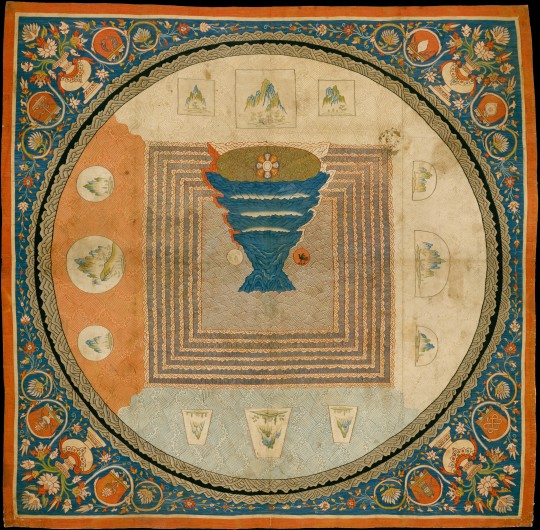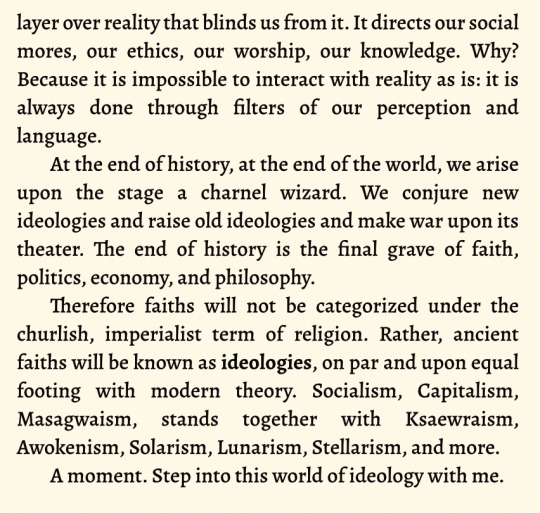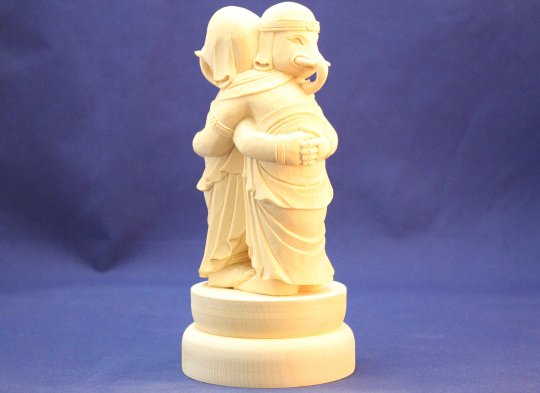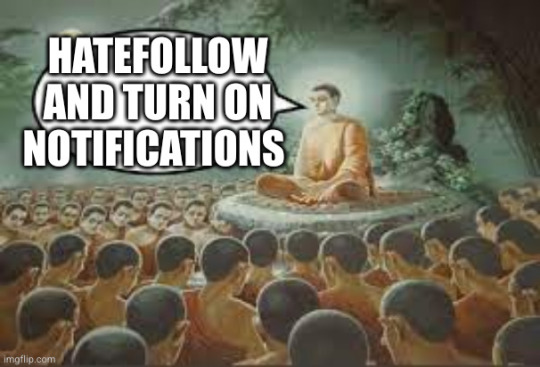#esoteric buddhism
Explore tagged Tumblr posts
Text

Cosmological Mandala with Mount Meru. China. 14th century.
53 notes
·
View notes
Text

The swordgendered, non-binary MC of THE KNIGHT VAGRANT. Raxri Uttara, The Once-Dead, for they were murdered, betrayed by Heaven and the Earth. Shorn of all memory and all cultivation, they must claw their way up the rungs of power once again until their fingers are bloody and raw.
"Stop! Stop! It is better to give up! It will take a million years to get back from where you were!" No matter to Raxri Uttara. Their vengeance is their meditation. One step at a time, until all beings are free. Until the world's mysteries are revealed. Until their will is done.
What is a hurricane to an ant? They are inextricably connected, Raxri would say. They are both immovable and unstoppable. A monsoon of swords.
Unassuming by nature, they are nonetheless wracked by a deep, indescribable sorrow, depression, guilt, and anxiety, which they push through by taking things one step at a time. Extremely versatile, Raxri is not one to master a single Violent System or Magickal Praxes, choosing instead to learn as many different systems as they can.
Name: Raxri Uttara Epithets: Once-Dead, The Heaven Dancer, The Swordhand, They Who Danced Against The Heavens Cultivation Level: 4 Mortal State (Accumulation Stage of the Desire Domain) Arcana: The Holy Fool Star Omen: The Water Bearer Blood Type: Air Violent Systems: Whorl Hand, Adamantine Sword Magickal Praxes: Mantra, Mudra Signature Technick: << ADAMANTINE SWORD: ADAMANT LIGHTNING STRIKES >> Likes: All food (especially rice meals), betel nut chewing, smoking, reading manuscripts, learning new Cultivation Systems, killing, stronger opponents, learning new technicks and magicks Dislikes: Poetry, writing, too sweet pastries, those that willingly misinterpret the Law, philosophy
THE KNIGHT VAGRANT?
THE KNIGHT VAGRANT is a spiritpunk progression ultrafantasy web novel in the universe of HINGSAJAGRA, a world wrought from Monsoon Asia and Esoteric Buddhism. Monsoon Asia Disco Elysium Xianxia.
Art by: @coldhazzard!
#the knight vagrant#fantasy#writing#web serial#southeast asia#monsoon asia#new weird#esoteric buddhism
28 notes
·
View notes
Text
Now listen, I adore Nero. Absolute icon, fabulous Camp Queen!!! She's a joy in almost every form that she appears in. She's always giving pussy pussy cunt cunt meow meow purr purr diva!!! Both of her Beast forms have great designs (obviously not counting the loli form) , Last Encore was an enjoyable watch and not anywhere near as bad as it's worst critics paint it as. And the stealth Last Encore / Arcade collab event for FGO was great!
.................... That being said, if you had to pick only one character to be the lead heroine / female face of the Fate Extra series, and you aren't going with Sakura/ BB, then the only sensible choice is Tamamo no Mae.
And I have very good evidence to backup that argument!
We know that Twice is like this super narrative foil for Hakuno, Twice's original servant was Tamamo. His new servant Saver is Shakyamuni, Shakyamuni and Tamamo are both manifestations of Vairocana.
Kiara the principal antagonist of CCC besides BB, is from a cult of Esoteric Buddhists who worship Amaterasu/ Vairocana via Dakiniten who is Tamamo's higher self /older incarnation (and is also the source for Tamamo's Witchcraft Skill) Kiara is herself a very deliberate inversion of Saver and is the only other candidate we know of for certain that qualifies for that class.
Benzaiten/ Saraswati who is a component of Meltryllis and Durga who is a component of Lip are also both goddesses considered to be manifestations of / syncretized with Amaterasu by different schools of Japanese Esotericism.
Narratively and dramatically I just feel like it has the biggest impact if Tama-chan is Hakuno's Servant.
#type moon#fate series#nasuverse#fate extra#fate extra ccc#fate grand order#fate extella#last encore#nero claudius#tamamo no mae#kiara sessyoin#dakiniten#hakuno kishinami#esoteric buddhism
15 notes
·
View notes
Text
More on the Origins of Sun Wukong's Golden Headband
I've previously suggested that the Monkey King's golden headband (jingu, 金箍; a.k.a. jingu, 緊箍, lit: “tight fillet”) can be traced to a ritual circlet mentioned in the Hevajra Tantra (Ch: Dabei kongzhi jingang dajiao wang yigui jing, 大悲空智金剛大教王儀軌經, 8th-century). This is one of the "Five Symbolic Ornaments" or "Five Seals" (Sk: Pancamudra, पञ्चमुद्रा; Ch: Wuyin, 五印; a.k.a. "Five Buddha Seals," Wufo yin, 五佛印), each of which is associated with a particular Wisdom Buddha:
Aksobhya is symbolised by the circlet, Amitabha by the ear-rings, Ratnesa by the necklace, Vairocana by the hand ornaments, [and] Amogha by the girdle (Farrow, 1992, p. 65). [1] 輪者,表阿閦如來;鐶者,無量壽如來;頸上鬘者,寶生如來;���寶釧者,大毘盧遮那如來;腰寶帶者,不空成就如來。
Akshobya is known to have attained Buddhahood through moralistic practices (Buswell & Lopez, 2014, p. 27). Therefore, this explains why a headband would be used to rein in the unruly nature of a murderous monkey god.
The original Sanskrit Hevajra Tantra calls the circlet a cakri (चक्रि) or a cakrika (चक्रिका) (Farrow, 1992, pp. 61-62 and 263-264, for example), both of which refer to a "wheel" or "disc." The Chinese version uses the terms baolun/zhe (寶輪/者, "treasure wheel or ring") and just lunzhe (輪者, "wheel" or "ring").
One of the more interesting things I've learned is that these ornaments were made from human bone. One source even refers to them as "bone ornaments" (Sk: asthimudra, अस्थिमुद्रा) (Jamgon Kontrul Lodro Taye, 2005, p. 493, n. 13). [1]
Can you imagine Sun Wukong wearing a headband made from human bone?! How metal would that be? Finger bones would probably do the trick.
Note:
1) Another section of the Hevajra Tantra provides additional associations:
The Circlet worn on the head symbolises the salutation to one's guru, master and chosen deity; the ear-rings symbolise the yogi turning a deaf ear to derogatory words spoken about the guru and Vajradhara; the necklace symbolises the recitation of mantra; the bracelets symbolises the renunciation of killing living beings and the girdle symbolises the enjoyment of the consort (Farrow, 1992, p. 263-264). 謂頂相寶輪者,唯常敬禮教授阿闍梨及自師尊;耳寶鐶者,不樂聞說持金剛者及自師尊一切過失、麁惡語故;頸寶鬘者,唯常誦持大明呪故;手寶釧者,乃至不殺蠕動諸眾生故;腰寶帶者,遠離一切欲邪行故。
2) For more info on the association between Hindo-Buddhist practices and human remains, see "charnel grounds".
Sources:
Farrow, G. W. (1992). The Concealed Essence of the Hevajra Tantra: With the Commentary Yogaratnamālā. Delhi: Motilal Banarsidass.
Jamgon Kontrul Lodro Taye (2005). The Treasury of Knowledge, Book Six, Part Four: Systems of Buddhist Tantra (The Kalu Rinpoche Translation Group, Trans.). Ithaca, NY: Snow Lion.
#Golden headband#tight fillet#Sun Wukong#Monkey King#Esoteric Buddhism#Vajrayana Buddhism#ritual#Journey to the West#JTTW#Lego Monkie Kid
54 notes
·
View notes
Text
Tantric synthesis
There's a heuristic coming along that feels close to something I've been wanting to find for a long time. It all comes down to hongaku (original enlightenment) on the one hand, and Tantric and theurgic non-dualism on the other hand, and from there I think I have a way of making some interesting connections possible.
When I read Hellenic Tantra during the last week or so I noticed that Gregory Shaw tries repeatedy to establish a connection between the concept of the theurgist and the jivanmukta at least on the grounds that both meant that the individual practitioner would become divinised while embodied and alive (though only fully joining the gods after death). Well, it turns out there's a Japanese Buddhist concept that's at least somewhat similar to the premise of the Tantric jivanmukta and Neoplatonist theurgy, or at least the way Shaw presents them. The Japanese term "sokushin jōbutsu" means to "become a Buddha in this body", and it seems to have originated in Shingon Buddhism.
"Sokushin jōbutsu" refers to the Shingon doctrine that buddha-nature could be realised in your own present lifetime, in your present body, in your present appearance (maybe now even). This idea is often attributed to Kukai, the founder of Shingon himself, who may have adapted it from Chinese esoteric Buddhism. Different versions of the concept were proposed by Saicho, another Shingon scholar, who accepted a partial realisation of buddhahood, and Annen, a Tendai scholar, who viewed it as the full attainment of buddahood in this life.
For Kukai this involved the practice of mudras, mantra recitation, mental concentration, and visualisations, which were supposed to lead to unification or mutual identity with the Buddha Mahavairocana. If this sounds like how Gregory Shaw talked about Tantra, well...
Maybe it's to do with the fact that Shingon has its roots in Tantric Buddhist traditions, or Kukai's own background in that tradition studying the tantras, or that at a certain point the Japanese concept of Mikkyo (esoteric Buddhism) generally denoted a kind of Tantric Buddhism. That Tantric Buddhism was also very obviously, to some extent, inspired by Hindu Tantra, with its inclusion of Hindu gods and often centrally centering the gods of Shaiva Hinduism. This seems to have been especially true for medieval Tendai given the role of deities like Mahakala and Kojin.
The doctrine of "sokushin jōbutsu" also seems to have involved collapsing any difference between physical and "ultimate" reality, the human body and the "dharma body", and positioning the body (and matter) itself as the site of realisation and a symbol of the entire universe. This form of nondualism probably did align with Tantric Hinduism to some extent. In fact, as Faure notes, Hindu Tantra itself developed from the Vedic tradition and inherited an originally Vedic conception of the human body as a microcosm of the universe.
It is on this basis that Tantra proposed the mutual identity of the human and the universe, and so Faure interprets Tantric Buddhism as having returned to the Vedic micro-macrocosmic vision. The Shingon doctrine of buddhahood involving Mahavairocana seems to match this vision. Faure also interprets this as a departure from earlier and more ascetic forms of Buddhism. In fact, he suggests that, in India, Tantric Buddhism assimilated the gods of Hinduism so successfully that it ended up losing distinctions from Hinduism, and folding back into Hinduism.
This obviously did not happen with Japanese or Chinese esoteric Buddhism. But, in Japan, Tantra can still be seen at the root of Mikkyo, and, as Nobumi Iyanaga observed, Shaiva Hindu deities played a special role in medieval esoteric Buddhism.
Both Tendai and Shingon are accepted as developments of Tantric Buddhism, in the sense that esoteric Buddhist derived from the larger Tantric tradition, and in that sense it seems the concept of hongaku seems was just part of Japanese Tantric Buddhism.
Although the formal concept of original/innate enlightenment did not originate (at least in these terms) in Tantric Hinduism, it seems to have definitely been part of the Tantric Buddhist milieu in Japan. And if you think about it, that makes sense given the logic of hongaku. Tendai hongaku establishes a collapse of the boundaries between ignorance or passion and enlightement or dharmarata, and therefore the distinction between the demons and the buddhas/gods, but it also logically connects to Mikkyo notions of matter as a symbol of the universe or the Buddha-mind. In that sense, it's hard to not connect hongaku to Tantric philosophy and its nondualist logic. And from there you can access the larger significance of the demon gods in Tantric terms. I'd even argue you have all you need for a kind of "Tantric synthesis".
And what's more, you can get to a sense of that kind of cosmic vision in the way Shaw describes theurgy or for that matter its goetic origins and correspondence as elaborated by Kent, and then there's extent to which can actually apply them to each other. After all, in pagan Neoplatonism, the body of the theurgist, while embodied and alive, is to be figured as a synthema for the divine or the creative activity of the Platonic Demiurge or Helios, and in a way you can kind of parallel that with what sokushin jōbutsu entails.
What comes next, of course, is the erotic significance. In Japan, Tantric esotericism that at least allegedly involved outright sexual rituals was called sadō mikkyō, which basically meant heterodox esoteric Buddhism, or "left-handed esotericism", as in the Left Hand Path. That the Left Hand Path should be directly defined by eroticism or sexual ritual is not surprising: it logically follows from the way the terminology was applied in Hinduism. But, in Japan, it also allowed some esoteric Buddhist schools to single out their rivals as heretics. It probably also dovetails nicely with efforts of some schools to define themselves as "pure" schools, focused only on Buddhahood, as opposed to "mixed" schools, allegedly only focused on worldly goals: a line functionally identical to Iamblichus' on theurgy versus goetia.
But this is an area where, real or imagined, the Left Hand Path points to the possibility of religious and magical eroticism as a vital if not fundamental element of the body as the site of spiritual realisation, which is critical to understand socially as a realm of freedom. The heuristic of "Tantric synthesis" here would function as a backdrop for the Left Hand Path as a pursuit of supra-cosmic individualism through an autonomous embrace of eroticism and mystical transgression, divinising the self by collapsing extant normative distinctions.
#tantra#tantric hinduism#tantric buddhism#esoteric buddhism#japanese buddhism#shingon#tendai#left hand path#buddhism#hinduism#neoplatonism#paganism#theurgy#hongaku
18 notes
·
View notes
Text
#buddhism#esoteric#esoterism#esoteric buddhism#shingon buddhism#japan#occult#religion#sailor moon#shugendo#tantra#thelema#shingon#acala#pagan#paganism
2 notes
·
View notes
Text
Dainichi Nyorai (the sun) also dies - Esoteric Buddhism 2 (essay)

In 1995, Shoko Asahara, the founder of Aum Shinrikyo, who caused the subway sarin gas attack in Japan that killed and injured thousands of people, said that Esoteric Buddhism was a superior sect within Buddhism. In Japan, there is a tendency to praise Kuukai, who introduced esoteric Buddhism, as an exceptional religious figure. Is that so? The supreme deity of Esoteric Buddhism is Dainichi Nyorai, the incarnation of the sun. Kuukai has been certified as Dainichi Nyorai through rituals, so he is a hardcore figure.
The blazing sun is a being that never rests for a moment, emitting energy of light and heat and giving blessings to all things. However, science teaches: ``The sun also has a lifespan, and someday it will burn out and die.''Currently, the sun is in its prime, but the teaching of Buddhism is that everything that exists is subject to ``birth, old age, illness, and death.'' This is the fundamental point, and the Buddha made his argument from there. It would be foolish to think that only the sun can escape birth, old age, disease, and death. It is irrational to think that the sun will live forever by capturing only a fleeting moment of life.In that sense, the teachings of Esoteric Buddhism go against the entire teachings of Buddhism and are laughable.
By the way, as proof of the worship of light and heat, there is a strange practice in Esoteric Buddhism called ``burning goma,'' in which a pedestal is made of wood and a fire is lit inside. It seems like they want to imitate the energy of the sun's light and heat, but even if they repeat this childish behavior, certain death will come to them. It would be a wasted effort. You could say that Kuukai was an idiot.
Rei Morishita
大日如来(太陽)も死ぬー密教2(エッセイ)
1995���、日本で地下鉄サリン事件を起こし、数千人を死傷させたオウム真理教の教祖:麻原彰晃は、密教が仏教のなかで優れた宗派であるとしていた。確かに日本では密教を伝えた空海を格別な宗教人として称える風潮がある。そうなのだろうか?密教の最高神は大日如来であり、太陽の化身である。空海自身、儀式で大日如来であると認定されているから、筋金入りである。
燃え盛る太陽、一瞬たりとも休まず光や熱のエネルギーを発散し、万物に恵みを与える存在。だが、科学は教える:「太陽にも寿命があり、いつかかならず燃え尽き、死ぬ。」今現在太陽は壮年期であるが、存在するものには必ず「生老病死」があるというのが、仏教の教えの根本であり、仏陀はそこから論を立てた。太陽だけが「生老病死」から逃れられると考えるのは、愚かだと言えよう。生の一瞬のみとらえて太陽が永遠に生きると考えるのは不合理だ。
その意味で、密教の教えは仏教の教え全体に背くものであり、笑止である。
ちなみに、光と熱を崇めるという証拠に、密教では「護摩を焚く」といって、木を組んで台座を作り、その中で火を燃やすという奇習がある。よほど太陽の光と熱のエネルギーにあやかりたいのだと思われるが、こんな児戯に類する行為を繰り返しても、確実な死が、その者たちにやってくるのだ。無駄な努力であろう。空海は、馬鹿だと言ってよいだろう。
4 notes
·
View notes
Text
Book of the Day - Mind Beyond Death
Today’s Book of the Day is Mind Beyond Death, written by Dzogchen Ponlop in 2007 and published by Snow Lion. Dzogchen Ponlop Rinpoche is a prominent Tibetan Buddhist teacher and scholar, and a meditation master. He is an abbot of Dzogchen Monastery, founder and spiritual director of Nalandabodhi, and founder of Nītārtha Institute for Higher Buddhist Studies. He is one of the highest tülkus in…

View On WordPress
#awakening#awareness#Bardo#Book Of The Day#book recommendation#book review#Buddhism#Buddhism Master#Buddhist teaching#enlightenment#Esoteric Buddhism#Esoterism#Raffaello Palandri#Tantra#transition
5 notes
·
View notes
Text
Manjushri
Manjushri is one of the most important iconic figures in Mahayana Buddhism and is known as the Bodhisattva of Great Wisdom. He is worshipped as the "Meditational Deity" in Esoteric Buddhism. The Sanskrit name of Manjushri is "Prajna," which means "gentle glory," "He who is noble and gentle," "soft glory," "Wondrous Auspiciousness," and so on. Buddhist monasteries' meditation halls, libraries, and study rooms often consist of images of Manjushri Bodhisattva. Manjushri is a famous Bodhisattva respected greatly in Chinese, Esoteric, Tibetan Buddhism, etc. Read more at: Manjushri Bodhisattva | Four Great Bodhisattva in China (originalbuddhas.com)

1 note
·
View note
Text

my post-christian, zizekian, lacanian take on fantasy religions for Hingsajagra
This conception of faith and religion comes from a long deep dive into the Philosophy of Religion, the formation of religion, and, sociopolitical philosophy. The formation of religion creates a sort of separation of religion from the rest of life, whereas other regions of the world consider religion to be intricately woven into their social and cultural mores. The Utter Islands, at the end of the world, begins to understand the nonduality of culture and religion as the social structures that once put up this separation crumble. Therefore, religion, political theory, social theory, and even science is raised to a single stage: the stage of Ideology.
Of course, all of this is not a thing universally agreed upon by all the philosophers across the vaunted Utter Islands. However, the categorization has become a useful lingua-franca to use and has risen to popularity in the end of the world, and is now being used by survivor-philosophers and ruin-savants to think of the most important question yet: what will the new world be?
closeups



#worldbuilding#fantasy#ultrafantasy#mysticpunk#swordpunk#monsoon asia#esoteric buddhism#leftist#writing#southeast asia
19 notes
·
View notes
Text
#スピリチュアル#spiritual#medium#占い#霊視#ミディアム#ミディアムシップ#霊能者#占星術#神護寺#空海#密教#展覧会#毘沙門天#四天王#Bishamonten#esoteric buddhism#インスタライブ#スピリチュアリズム#Vaiśravaṇa#スピリチュアルカウンセラー#東京国立博物館#上野#多聞天#持国天#クベーラ
0 notes
Text
Always love it when you can find parts of Tantra that can connect to pagan practices
On Astrolatry
According to wikipedia: “Astrolatry is the worship of stars and other heavenly bodies as deities, or the association of deities with heavenly bodies.” In some beliefs, astrology and divinity are the same thing. The practice was historically common in Asia and in certain Asian countries (such as my home of Thailand) it still occurs.
As in classical Indian astrology, Thai astrology and Thais in general to this day believe astrological heavily bodies are gods (deva, Thai: tep) as well as material astronomical objects. Presently in Central Thailand, the worship of Rahu as the god of luck and fortune has become quite popular.
- Astrology Through History by William Burns
Astrology to the Burmese meant not only the methods of tracing the courses of the planets and their influence on the mortals, but also the ritual by which the planets were appeased and made to withdraw their baneful influence. In other words, it involved a worship of the planets. As Burmese astrology had its origins in Hindu astrology, so the worship of he planets involved worship of at least some of the Hindu gods.
- Folk Elements in Burmese Buddhism by Muang Htin Aung
The worship of the asterims and heavenly bodies played an important role in Esoteric Buddhism in China, and the rest of East Asian cultures. Although many of the cults may have originated in China, it would appear that the strong identification between certain Buddhist divinities and the worship of the planets was a Chinese phenomenon.
- Esoteric Buddhism and the Tantras in East Asia
More personal anecdotes along with some pondering below.
Keep reading
129 notes
·
View notes
Text
I think I'm getting into a kind of madness with this one.
#demonology#demons#demon god war#paganism#satanism#satanic paganism#left hand path#japanese buddhism#esoteric buddhism#be warlike
8 notes
·
View notes
Text
Kuukai and the Rishukyo: It’s meaningless- This guy is an idiot (Esoteric Buddhism-1)

The sect that Kuukai founded is a major sect of esoteric Buddhism called Shingon Buddhism, and its temples are scattered throughout Japan. One time, I went to see a Shingon sect festival in my area. One word: gorgeous! It was a truly spectacular ceremony that made effective use of lanterns.
Now, after looking at it and thinking about it, I concluded that it was "too gorgeous!!" The Shingon sect seems to hold extravagant festivals without exception. Looking back, the scene when Kukai received the transmission ceremony from his master Huiguo in Chang'an, the capital of the Tang Dynasty where esoteric Buddhism was popular, can only be described as gorgeous. Surrounded by brightly colored ornaments, Kukai threw flowers at the Buddhas, and childishly, the Buddha would unite with the guardian deity of the Buddha whom he had thrown. He became a Tathagata.
If you want to convey the state of enlightenment, a more modest ceremony should be sufficient. Not doing so seems like a desire to "protect the nation," a desire to bypass personal salvation (enlightenment) and become involved in the fate of the nation. Shingon Buddhism is the perfect way to demonstrate the power of the nation. In other words, it's a "bluff".
Another point of contention is the strange description of Rishukyo, one of the fundamental scriptures of the Shingon sect. What it says is that when a young man and woman get to know each other, love develops, and they embrace each other with feelings that reach heaven, they are at the ``bodhisattva level'' (purity). In normal Buddhism, romantic feelings between men and women are usually excluded, so the description in the Rishūkyō stands out.
When it comes to human love, it's normal for two people to end up on the other side, and the scary situation of a love triangle often occurs. The moment a loved one of the opposite sex is abducted by someone of the same sex, the person concerned falls into hell instead of heaven. A bodhisattva quickly turns into a sinner in hell. As someone who has experienced this bitter love triangle, I declare that the Rishukyo sutra is falsehood. Kuukai is an idiot who made this the basic scripture.
Rei Morishia
2 notes
·
View notes
Text
This meme was brought to you by the Fudo-Myoo gang

10K notes
·
View notes
